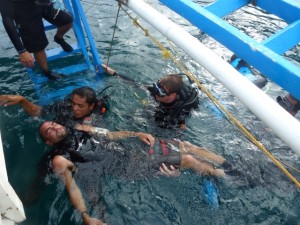Teaching my first course
After I took my PADI Instructor Development Course I was looking forward to teaching my first course and couldn’t wait to see who my first students would be.
I wanted to introduce others to the sport that I had fallen in love with. The opportunity to take someone underwater for the first time was something that I was looking forward to.

Then finally I had the knock at my door. I mean that quite literally, as I was still in bed when a fellow instructor woke me up by banging on my front door. With that disoriented feeling, you get when woken up suddenly, I fumbled to open the door and see what the commotion was all about.
“Do you want to teach a course today?”
“Huh?” was all I could think to mumble before my brain caught up with the question.
Of course, I wanted to teach a course. It was my big moment, someone was going to try diving for the first time and I was going to be their instructor. Awesome.
I figured I would have a coffee and take a look through my instructor manual so that I was prepared to meet my student. Then I was informed that my student was already in the shop filling out paperwork and I was to start class in 5 minutes. Only 5 minutes to prepare for my first ever Open Water student?
I thought that I could pull it off. But just as I was coming to grips with that is when the other shoe dropped. I was told that “Oh, by the way, it’s a Rescue Course”.
Rescue? Really?
That’s how I got my first Rescue student. It was the first course that I ever taught. And to top it off, I would need to teach the Medic First Aid course as well. (this was before Emergency First Response existed)
Now I love Rescue, but at the time it was incredibly daunting to have to walk into the classroom and dispense that type of knowledge and teach those skills.
I was still coming to grips with thinking of myself as an actual scuba instructor, especially as I had yet to do any real teaching. I could lead dives and knew my way around the dive center, boat and dive sites, but this was different.
Teaching the Rescue Diver course is hard work. In the evenings, I would look over what needed to happen the next day and try to plan out skill practice and scenarios.

You have to subtly manipulate the training so that skills build naturally and your student gets the opportunity to learn from their mistakes. By the end of the course, the student needs to be able to do the skills correctly without over thinking them. Repetition is the key to learning emergency skills and procedures.
For the Instructor, you have to be constantly aware and be able to spot small problems with the skills and keep your student engaged. Of course, there is a tendency for instructors to go overboard (literally and figuratively) when conducting a Rescue course. But maintaining the balance between making a student work hard and breaking them has to be respected.
It turned out to be a great course, at least for me. I learned a lot in those few days. I was pulled far from my comfort zone and had to think on my feet to try to teach the course as best as I could.
I have taught hundreds of Rescue courses since that first one, but as they say “you never forget your first”. And as it so happens, she is now an instructor as well. Several years ago I met up with her and we had a good laugh over the fact that she was my first student.
As a fellow instructor, she knew all too well how it feels to teach a course for the first time. It breathes new life into your teaching, which is why I always encourage my Instructor candidates to learn to teach some specialty diver courses. Teaching entry level courses like DSD’s and the Open Water Diver Course are rewarding and fulfilling but by teaching a wide range of courses you become a stronger Instructor overall.
As a new Instructor, don’t assume your first student will be new to diving. In fact, your first student could be a Divemaster Trainee!
To all the Instructors out there. What was your first course?
Tim

